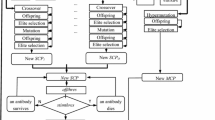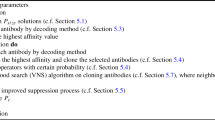Abstract
This paper uses an immune algorithm (IA) meta-heuristic optimization method to solve the problem of structure optimization of series-parallel production systems. In the considered problem, redundant machines and buffers in process are included in order to attain a desirable level of availability. A procedure which determines the minimal cost system configuration is proposed. In this procedure, multiple choices of producing machines and buffers are allowed from a list of product available in the market. The elements of the system are characterized by their cost, estimated average up and down times, productivity rates and buffers capacities. The availability is defined as the ability to satisfy the consumer demand which is represented as a piecewise cumulative load curve. The proposed meta-heuristic is used as an optimization technique to seek for the optimal design configuration. The advantage of the proposed IA approach is that it allows machines and buffers with different parameters to be allocated.
Similar content being viewed by others
References
Beji, N., Jarboui, B., Eddaly, M., & Chabchoub, H. (2010). A hybrid particle swarm optimization algorithm for the redundancy allocation problem. Journal of Computational Science. doi:10.1016/j.jocs.2010.06.001.
Billiton R., Allan R. (1984) Reliability evaluation of power systems. Pitman, London
Brownlee, J. (2007). Clonal selection algorithms, technical report. Victoria, Australia: Complex Intelligent Systems Laboratory (CIS), Centre for Information Technology Research (CITR), Faculty of Information and Communication Technologies (ICT), Swinburne University of Technology; 2007 Feb; Technical Report ID: 070209A.
Campelo F., Guimares F. G., Igarashi H., Ramirez J. A., Noguchi S. (2006) A modified immune network algorithm for multi-modal electromagnetic problems. IEEE Transactions on Magnetics 42(4): 1111–1114
Chen T. C. (2006) IAs based approach for reliability redundancy allocation problems. Applied Mathematics and Computation 182: 1556–1567
Chen T. C., You P. S. (2005) Immune algorithms-based approach for redundant reliability problems with multiple component choices. Computers in Industry 56(2): 195–205
Chern M. S. (1992) On the computational complexity of reliability redundancy allocation in a series system. Operations Research Letters 11: 309–315
Chu C. W., Lin M. D., Liu G. F., Sung Y. H. (2008) Application of immune algorithms on solving minimum-cost problem of water distribution network. Mathematical and Computer Modelling 48: 1888–1900
Coelho L. S. (2009) An efficient particle swarm approach for mixed-integer programming in reliability–Redundancy optimization applications. Reliability Engineering and System Safety 94: 830–837
Coello C. A. C., Cortes N. C. (2004) Hybridizing a genetic algorithm with an artificial immune system for global optimization. Engineering Optimization 36: 607–634
Danzhen, G., Qian, A., & Chen, C. (2008). The application of artificial immune network in load classification. In Third international conference on electric utility deregulation and restructuring and power technologies, 6–9 April, Nanjing, China (pp. 1394 – 1398).
Dasgupta D. (1999) Artificial immune systems and their applications. Springer, Berlin, Heidelberg
Dasgupta, D., KrishnaKumar, K., Wong, D., & Berry, M. (2004). Negative selection algorithm for aircraft fault detection. Artificial immune systems. In Proceedings of ICARIS 2004, Springer (pp. 1–14).
De Castro, L. N., & Timmis, J. (2002a). An artificial immune network for multimodal function optimization. In WCCI proceedings of the 2002 world on congress on computational intelligence (Vol. 1, pp. 699–704).
De Castro L. N., Timmis J. (2002b) Artificial immune systems: A new computational intelligence approach. Springer, London, Berlin, Heidelberg
De Castro L. N., Timmis J. (2003) Artificial immune systems as a novel soft computing paradigm. Soft Computing 7: 526–544
De Castro, L. N., & Von Zuben, F. J. (2000). An evolutionary immune network for data clustering. In Proceedings of the IEEE SBRN (Brazilian Symposium on Artificial Neural Networks), Rio de Janeiro, 22–25 November (pp. 84–89).
De Castro L. N., Von Zuben F. J. (2002) Learning and optimization using the clonal selection principle. IEEE Transactions on Evolutionary Computation 6(3): 239–250
Dolgui A., Eremeev A. V., Sigaev V. S. (2007) HBBA: Hybrid algorithm for buffer allocation in tandem production lines. Journal of Intelligent Manufacturing 18: 411–420
Farmer J., Packard N. H., Perelson A. (1986) The immune system, adaptation and machine learning. Physica D 22: 187–204
Forrest, S., Perelson, A. S., Allen, L. & Cherukuri, R. (1994). Self–nonself discrimination in a computer. In Proceedings of IEEE symposium on research in security and privacy, Oakland, CA, Springer (pp. 202–212).
Gen M., Yun Y. S. (2006) Soft computing approach for reliability optimization: State-of-the-art survey. Reliability Engineering and System Safety 91(9): 1008–1026
Harmer P. K., Williams P. D., Gunsch G. H., Lamont G. B. (2002) An artificial immune system architecture for computer security applications. IEEE Transactions on Evolutionary Computation 6(3): 252–280
Harris R. S., Kong Q., Maizels N. (1996) Somatic hypermutation and the three R’s: Repair, replication and recombination. Mutation Research 436: 157–178
Hart E., Timmis J. (2008) Application areas of AIS: The past, the present and the future. Applied Soft Computing 8: 191–201
Helber S. (2001) Cash-flow-oriented buffer allocation in stochastic flow lines. International Journal of Production Research 39: 3061–3083
Hofmeyr S., Forrest S. (2000) Architecture of an artificial immune system. Evolutionary Computing 8(4): 443–473
Hou T.-H., Su C.-H., Chang H.-Z. (2008) An integrated multi-objective immune algorithm for optimizing the wire bonding process of integrated circuits. Journal of Intelligent Manufacturing 19: 361–374
Huang S. J. (2002) Application of immune based optimization method for fault-section estimation in a distribution system. IEEE Transactions on Power Delivery 17: 779–784
Huang S. T. (2000) An immune-based optimization method to capacitor placement in a radial distribution system. IEEE Transactions on Power Delivery 15: 744–749
Hunter J. S. (1985) Statistical design applied to product design. Journal of Quality Technology 17: 210–221
Jerne N. (1974) Towards a network theory of the immune system. Annuals of Immunology 125: 373–389
Kimura T. (1996) Optimal buffer design of an M/G/s queue with finite capacity. Stochastic Models 12(1): 165–180
Kumar R., Izui K., Masataka Y., Nishiwaki S. (2008) Multilevel redundancy allocation optimization using hierarchical genetic algorithm. IEEE Transactions on Reliability 57(4): 650– 661
Kuo W., Prasad V. R. (2000) An annotated overview of system-reliability optimization. IEEE Transactions on Reliability 49(2): 176–187
Kuo W., Wan R. (2007) Recent advances in optimal reliability allocation. IEEE Transactions on Systems, Man and Cybernetics. Part A: Systems and Humans 37(2): 143–156
Laurentys C. A., Ronacher G., Palhares R. M., Caminhas W. M. (2010) Design of an artificial immune system for fault detection: A negative selection approach. Expert Systems with Applications 37(7): 5507–5513
Levitin G., Lisnianski A., Ben-Haim H., Elmakis D. (1998) Redundancy optimization for series–parallel multi-state systems. IEEE Transactions reliability 47(2): 165– 172
Levitin G., Lisniaski A., Elmakis D. (1997) Structure optimization of power system with different redundant elements. Electric Power System Research 43: 19–27
Levitin G., Meizin L. (2001) Structure optimization for continuous production systems with buffers under reliability constraints. International Journal of Production Economics 70: 77–87
Liang Y.C., Chen Y.C. (2007) Redundancy allocation of series-parallel systems using a variable neighborhood search algorithm. Realiability Engineering and System Safety 92: 323–331
Lisnianski A., Ding Y. (2009) analysis for repairable multi-state system by using combined stochastic processes methods and universal generating function technique. Reliability Engineering and System Safety 94: 1788–1795
Lutz C. M., Davis K. R., Sun M. (1998) Determining buffer location and size in production line using tabu search. European Journal of Operational Research 106: 301–316
Maslow A. H. (1954) Motivation and personality. Harper & Bros, New York
Massim Y., Yalaoui F., Amodeo L., Chatelet E., Zeblah A. (2010) Efficient combined immune-decomposition algorithm for optimal buffer allocation in production lines for throughput and profit maximization. Computers & Operations Research 37: 611–620
Massim Y., Zeblah A., Meziane R., Benguediab M., Ghouraf A. (2005) Optimal design and reliability evaluation of multi-state series–parallel power systems. Nonlinear Dynamics 40(4): 309–321
Matta, A., Pezzoni, M., & Semeraro, Q. (2010). A Kriging-based algorithm to optimize production systems approximated by analytical models. Journal of Intelligent Manufacturing. doi:10.1007/s10845-010-0397-0.
Meizin L. K. (1984) Choosing the optimal buffer stock between two section of a continuous process. Automation and Remote control 45(8): 1086–1089
Meizin L. K. (1987) Optimizing contingency reserve. Automation and Remote control 48(2): 268–271
Miyamoto A., Nakamura H., Kruszka L. (2004) Application of the improved immune algorithm to structural design support system. Journal of Structural Engineering ASCE 130(1): 108–119
Moghaddam R. T., Safari J., Sassani F. (2008) Reliability optimization of series–parallel systems with a choice of redundancy strategies using a genetic algorithm. Reliability Engineering and System Safety 93(4): 550–556
Nasaroui, O., Gonzalez, F., & Dasgupta, D., (2002). The fuzzy artificial immune system: Motivations, basic concepts, and application to clustering and web profiling. In Proceedings of the 2002 IEEE international conference on fuzzy systems (FUZZ-IEEE’02), Honolulu, HI, USA, 12–17 May, 1, (pp. 711–716).
Neal, M. (2003). Meta-stable memory in an artificial immune network. Artificial immune systems. In Procedings of ICARIS 2003, Springer (pp. 168–181).
Nourelfath M., Dutuit Y. (2004) A combined approach to solve the redundancy optimization problem for multi-state systems under repair policies. Reliability Engineering and System Safety 86: 205–213
Nourelfath, M., Nahas. N., & Zeblah. A. (2003). An ant colony approach to redundancy optimization for multi-state system. In International conference on industrial engineering and product management (IEPM’2003) Porto-Portugal.
Ouzineb M., Nourelfath M., Gendreau M. (2010) An efficient heuristic for reliability design optimization problems. Computers & Operations Research 37: 223–235
Plett, E., & Das, S. (2009). A new algorithm based on negative selection and idiotypic networks for generating parsimonious detector sets for industrial fault detection applications. Lecture notes in computer science, 5666/2009, pp. 288–300.
Ramirez-Marquez J. E., Coit D. (2007) Optimization of system reliability in the presence of common cause failures. Reliability Engineering & System Safety 92(10): 1421–1434
Saniee Abadeh, M., Habibi, J., Daneshi, M., Jalali, M., & Khezrzadeh, M. (2007). Intrusion detection using a hybridization of evolutionary fuzzy systems and artificial immune systems. In Proceedings of congress on evolutionary computation (CEC), 25–28 September, Singapore.
Taguchi G., Chowdhury S., Taguchi S. (2000) Robust engineering—Learn how to boost quality while reducing costs and time to market. McGraw-Hill, New York
Tian Z., Levitin G., Zuo M. J. (2009) A joint reliability–redundancy optimization approach for multi-state series-parallel systems. Reliability Engineering and System Safety 94: 1568–1576
Tiwari M. K., Prakash Kumar A., Mileham A. R. (2005) Determination of optimal assembly sequence using psycho-clonal algorithm. (IMechE), Part-B, Journal of Engineering Manufacture 219: 137–149
Tiwari M. K., Raghavendra N., Agrawal S., Goyal S. K. (2010) A hybrid Taguchi-Immune approach to optimize an integrated supply chain design problem with multiple shipping. European Journal of Operational Research 203(1): 95–106
Ülker E., Turanalp M. E., Halkaci H. S. (2009) An artificial immune system approach to CNC tool path generation. Journal of Intelligent Manufacturing 20: 67–77
Ushakov I. (1986) Universal generating function. Soviet Journal of Computer Systems and Science 24(5): 118–129
Ushakov I. (1987) Optimal standby problems and a universal generating function. Soviet Journal of Computer Systems and Science 25(4): 79–82
Wang X., Gao X. Z., Ovaska S. J. (2007) A hybrid optimization algorithm based on ant colony and immune principles. International Journal of Computer Science & Applications 4(3): 30–44
Wen X., Song A. (2004) An immune evolutionary algorithm for sphericity error evaluation. International Journal of Machine Tools and Manufactures 44(10): 1077–1084
Yalaoui A., Châtelet E., Chu C. (2005) A new dynamic programming method for reliability & redundancy allocation in a parallel-series system. IEEE Transactions on Reliability 54(2): 254–261
Yan, H. S., An, Y. W., & Shi, W. W. (2010). A new bottleneck detecting approach to productivity improvement of knowledgeable manufacturing system. Journal of Intelligent Manufacturing. doi:10.1007/s10845-009-0244-3.
Yildiz A. R. (2009) A novel particle swarm optimization approach for product design and manufacturing. International Journal of Advanced Manufacturing Technology 40: 617–628
Zandieh M., Fatemi Ghomi S. M. T., Moattar Husseini S. M. (2006) An immune algorithm approach to hybrid flow shops scheduling with sequence-dependent setup times. Applied Mathematics and Computation 180(6): 111–127
Zhang R., Wu C. (2010) Hybrid immune simulated annealing algorithm for the job shop scheduling problem. Applied Soft Computing 10(1): 79–89
Author information
Authors and Affiliations
Corresponding author
Rights and permissions
About this article
Cite this article
Massim, Y., Yalaoui, F., Chatelet, E. et al. Efficient immune algorithm for optimal allocations in series-parallel continuous manufacturing systems. J Intell Manuf 23, 1603–1619 (2012). https://doi.org/10.1007/s10845-010-0463-7
Received:
Accepted:
Published:
Issue Date:
DOI: https://doi.org/10.1007/s10845-010-0463-7




